Sedum & The Roundhouses
Over the past 12 years, Stanwick Lakes have been fortunate enough to receive Heritage Lottery funding for a number of projects exploring the history of the site and surrounding valley.
The first archaeological excavations were carried out before quarrying started at the site in 1985. These uncovered thousands of years of history at Stanwick Lakes.
Neolithic Long Barrows (c 3,700-3,500BC) and Bronze Age Round Barrows (c 2,500–1,500BC) were discovered at the Irthlingborough end of the site. Then, pottery, skeletons and cattle skulls were all found during further excavations.
Roman Influence
The remains of around 50 Iron Age roundhouses (c 400BC – 43AD) were found closer to the centre of the Stanwick Lakes site. Despite the arrival of the Romans, the site would have endured. Next to the roundhouse site the archaeologists uncovered the remains of a large Roman villa (c250 – 400AD) . This replaced a more modest original building. Thankfully, one of the mosaics from the roman villa was returned to Stanwick Lakes in 2013 and can be seen on display in the Visitor Centre.
The site became a large area of meadowland during the following centuries. It would have been surrounded by the open field ridge and furrow farming system and a few early enclosed fields. By the late 1830s the entire landscape had changed to enclosed fields. By now the meadowland had become a series of large fields.
1845 saw another major change with the opening of the Northampton and Peterborough railway. The track connecting the stations at Irthlingborough and Ringstead ran through the middle of what is now Stanwick Lakes. Initially, there were five trains each way on weekdays and Saturdays with two on a Sunday. The line was closed in 1964.
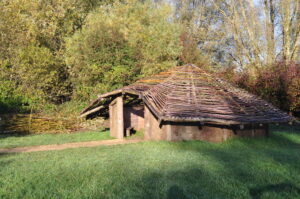 |
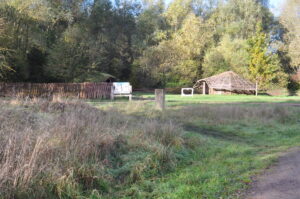 |
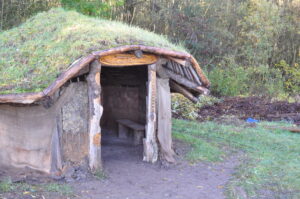 |
Gravel Extraction
More recently, visitors to the site today see a landscape shaped by the industrial activities of the late 20th century. Hanson began quarrying for gravel in 1985 at the northern end of the site and continued extraction until the end of 2004. Then the site was bought by East Northamptonshire Council. Trees were planted and the lakes created as part of the restoration work carried out by Hanson. Both now make Stanwick Lakes an important wildlife habitat.
Plans for the future
Over time, the barrow has started to erode because of water levels and invasive undergrowth. Over the next 3 years the site will be working with Historic England to make sure that the barrow is protected for future generations. Firstly, a regular maintenance plan will be agreed for the hedgerows and trees. This will include shoring up the edge nearest the railway ditch, and introduce a mesh covering to stop further erosion.
Many visitors to Stanwick Lakes walk past our one roundhouse, built in various forms since 2018 down by the edge of Celtic Lake. It was built there facing the site of the Iron Age settlement uncovered in the archaeological excavations in the 1980’s.
The plan is to transform this area into a typical prehistoric farm settlement. This will form the focal point for “Living History” experiences with schools, visitors and our communities. The settlement will be used to teach traditional crafting, immersive history and of course, community heritage events.
A second roundhouse…
As a partner we will be helping to build a second larger roundhouse. This will be designed with a ditch and a bund boundary, hurdle fencing and a small garden. This will showcase crops, herbs and plants from the time. The heritage garden will also be developing a “Living History Nursery” to cultivate plants for this area.
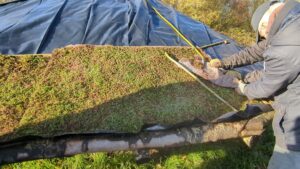 |
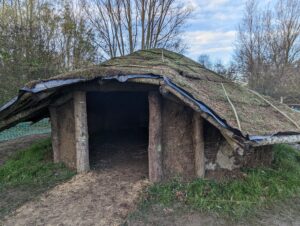 |
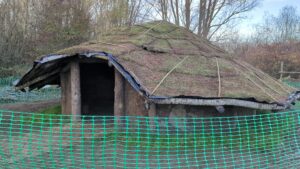 |
From the end of 2023 the Heritage Trail at Stanwick Lakes will boast green roofs on their roundhouses as we help to recreate part of the original Iron Age settlement. The aim of building a roundhouse is twofold. To provide a glimpse into the past of Stanwick Lakes and to create a focus for community heritage activities. The use of local materials and the involvement of local people are integral to the guiding principles.
The new roundhouse will have a sedum roof. This should give a really good idea of how the roundhouse would have looked but it will offer better longevity so that classroom groups can be hosted over the next five years or more.

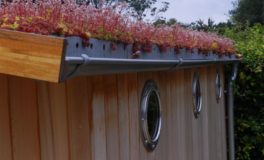 Sedum roof build-up
Sedum roof build-up 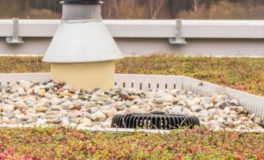 Sedum Species
Sedum Species 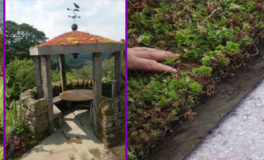 Sedum roof construction
Sedum roof construction 

